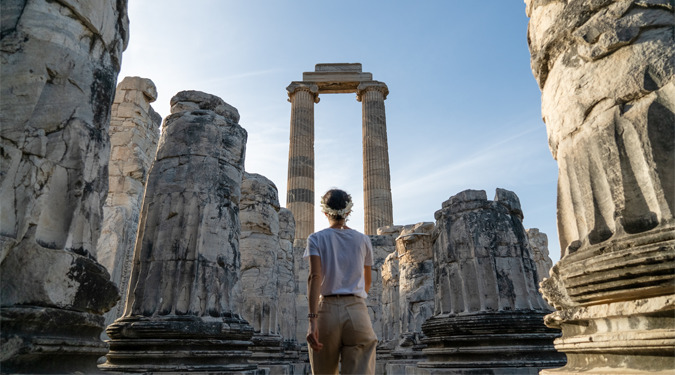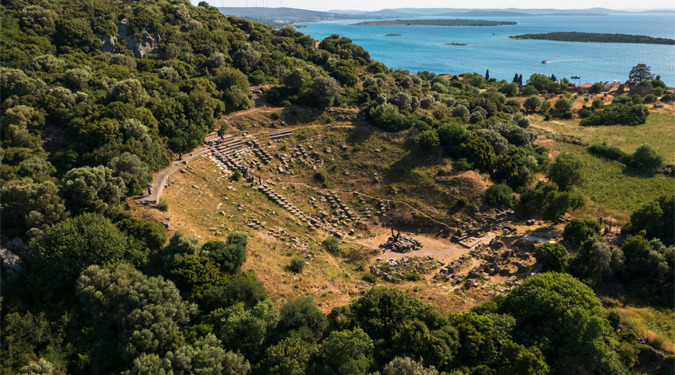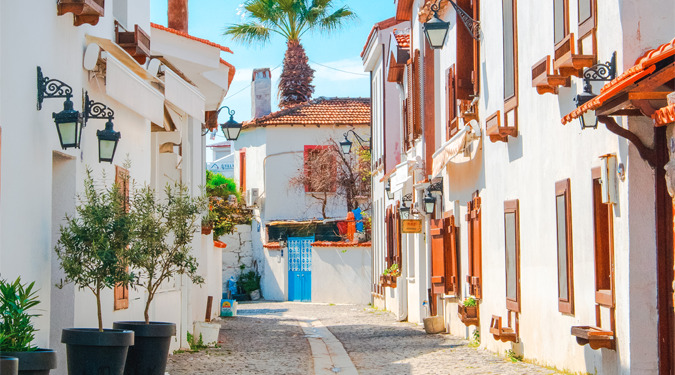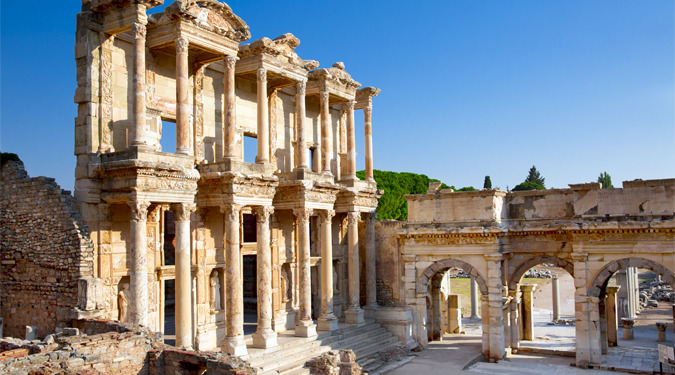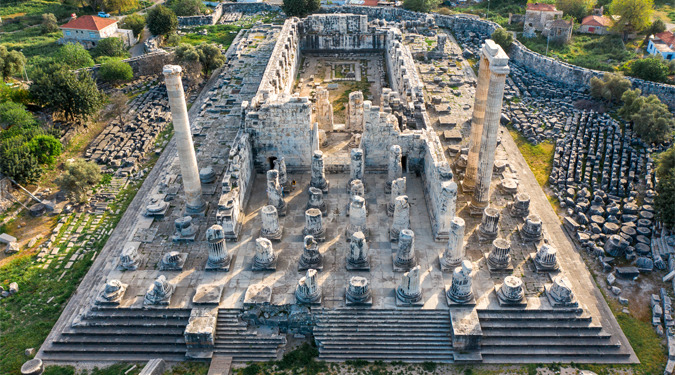

experiences
The Ionian Route
The Ionian Route: A Timeless Journey Across Millennia
Step into the world of Ionia, a land where every path leads not only to the shores of the Aegean but to the foundations of history, wisdom, and art that have shaped human civilisation. The Ionian Route invites you to walk in the footsteps of ancient poets, philosophers, and artists across cities that have been gateways to knowledge, culture, and inspiration for over three millennia. Enriched by stories and traditions passed down through generations, this route connects travellers with the living heart of Ionia, blending the mystical beauty of its ancient cities with the serene charm of today’s Turkish coastal towns.
Ionia, a remarkable union of powerful city-states, was the birthplace of some of history's most influential achievements in philosophy, literature, mathematics, art, and architecture. The Ionian League, also known as the Panionion, was founded in the Archaic period as a religious and political alliance, symbolizing the unity of the Ionian cities, and it continued to thrive into the Roman era. Today, the Ionian Route extends through the captivating districts of Foça, Çeşme, Urla, Seferihisar, Menderes, Selçuk, Söke, Didim, and Kuşadası—each destination offering a unique window into the past while celebrating the vibrant culture of modern-day Türkiye.
The Journey Begins: A Meeting of Past and Present
The Ionian Route begins in Foça (ancient Phokaia), a town of İzmir, an ancient city famed for its sailors and ancient maritime prowess. Today, as a member of Cittaslow network, Foça embraces the peaceful rhythms of life, making it an ideal starting point. Here, the echoes of Phocaean sailors venturing out to found distant colonies like Marseille can still be felt in the harbours and cobbled streets. Against a backdrop of lush landscapes, Foça invites you to relax, savour traditional Aegean cuisine, and join the locals in celebrating their enduring connection to the sea.
In the town of Ildırı, in Çeşme, the earliest traces of settlement in ancient Erythrai date back to 3000 BCE. The Temple of Athena and Herakleion are considered as structures that exhibit the best example of the Ephesus type in Anatolia, with their Ionic architectural order. You’ll wander through artichoke fields and cobblestone streets of the town of Ildırı before you climb up to the ancient theatre - Once an important harbour, this charming coastal town embodies the spirit of Ionian trade and craftsmanship, with its clear waters and breezy shores drawing visitors into its fold.
Travelling to Urla, you’ll step into ancient Klazomenai to witness one of the world’s oldest olive oil production dating back to 6th century BCE, a tradition that continues in the olive groves and vineyards of this town. The traces that we can accept as the founding phase of the city are in the nearby Limantepe mound, which has been inhabited since 4000 BCE. As you explore Urla, a destination also steeped in artistry and culinary delights, you’ll discover a cultural hub where the ancient meets the contemporary. The scent of olives, the charm of local artisans, and the vineyards stretching across the landscape create an ambiance that mirrors Klazomenai’s inventive spirit.
The journey continues through Teos and Lebedos, nestled within the tranquil region of Seferihisar, another Cittaslow town known for its dedication to preserving cultural heritage and nature In Teos, a city renowned for its association with the cult of Dionysus and once a hub for the Dionysian Artists, the echoes of wine festivals and artistic gatherings continue to resonate, inviting travellers to immerse themselves in the local rhythm. The city also houses one of the best-preserved ancient temples dedicated to Dionysus. Lebedos, with its serene ruins and captivating scenery, offers a peaceful escape, embodying Seferihisar’s commitment to sustainability and cultural preservation.
The Heart of Ionia: From Ephesus to Priene
No journey along the Ionian Anatolia is complete without visiting the legendary city of Ephesus (modern Selçuk). Designated as a UNESCO World Heritage Site, Ephesus is home to the Temple of Artemis, one of the Seven Wonders of the Ancient World, and was a centre of learning, commerce, and religious devotion. Today, the city’s grandeur lives on in its iconic marble streets, the Library of Celsus, and the Great Theatre, where thousands once gathered. As you wander through Ephesus, you’ll feel a profound connection to the voices of those who once walked these streets—poets, musicians, and thinkers who helped shape the course of history.
In Priene, known for its well-planned city layout on the southern foothills of ancient Mykale (Samsun) Mountain, the remarkable theatre overlooks the scenic Büyük Menderes, the longest river to flow into the Aegean. In antiquity, it was known as Maíandros, from which we get the term “meander” to describe sinuous curves in rivers and patterns in art. As you explore the city’s carefully arranged streets and buildings, you’ll see the Ionian commitment to harmony and beauty. Founded according to Hippodamos of Miletus’ plan, Priene is considered the first and most significant city to implement the Hippodamian Plan.
Further south, in the towns of Söke and Balat, in the ancient cities of Myus and Miletus, lies the heart of Ionian philosophy. Miletus, birthplace of great thinkers like Thales, Anaximander, and Anaximenes, was where early thought on nature, mathematics, and the cosmos was developed. Walking through Miletus’ expansive ruins, you can almost hear the echoes of these foundational discussions.
Not far from these sites stands the Temple of Apollo at Didyma, a monumental sanctuary dedicated to Apollo. Known for its impressive Ionic columns and precision, this temple remains one of the best-preserved examples of Ionic architecture. Once home to the Didyma Oracle, it was the second most significant oracle in the ancient world. Its imposing ruins continue to inspire awe, offering a glimpse into the sacred and architectural grandeur of the past.
A Living Bridge Between Past and Present
The Ionian Route isn’t only a passage through ancient ruins but also a journey through the vibrant towns that continue to honour their rich heritage.
Seferihisar and Foça’s Cittaslow values showcase Türkiye’s commitment to sustainability, community, and preserving the quality of life for future generations. This harmonious blend of past and present is what makes the Ionian Route truly special—connecting the ancient heritage of Ionia with the welcoming spirit of Turkish hospitality.
This living journey offers more than just historical exploration. As you traverse these historic roads, the experiences you gather will feel like pieces of a larger story—a story of human creativity, resilience, and connection to the land and sea.
So, if you are ready to embark on a journey that transcends time, the Ionian Route awaits you. Here, on the shores of the Aegean, the echoes of Ionia’s past harmonize with the vibrant pulse of today, inviting you to be part of a legacy that continues to inspire the world.

